The first volume of The Legend of Kamui, about the early Tokugawa shogunate, receives its first English translation

Billed as ‘the last great manga epic’ (that had not yet been translated into English), this is the first of a projected series of ten 600-page volumes, collecting Shirato Sanpei’s most famous manga. Set in seventeenth-century Japan, The Legend of Kamui was originally published as a monthly serial between 1964 and 1971 in cult alt-manga anthology Garo. It chronicles the various (and largely unpleasant) ways in which the feudal system and class hierarchies of the time (during the early part of the Tokugawa shogunate, 1603–1868) allowed a tiny group of samurai to control a much larger group of farmers, while simultaneously preventing either group from living their dreams. Kamui, our notional hero, is a puckish, kawaii-type child martial artist from the bottom of the social pile, the outcast class, who you could easily imagine reincarnated as a plush toy. Almost everything else in this tale, however, is rendered in a more gritty, and adult, down-to-earth style.
As his narrative web – of which Kamui is a part rather than the centre – slowly spins out through every level of this stratified society, Shirato constantly reminds us, not least in prose codas to each chapter, that the past is not a foreign country and that many of the prejudices that are ostensibly described as belonging to the age of sword-wielding maniacs and happy-go-lucky peasants remain present in society today. (And in nature, too, via a tangential story about a lone wolf who had been expelled from the pack because of the colour of his fur.) Between the faster-paced episodes of more-or-less violent oppression (hangings, disembowelments, dactylectomy, infanticide), and the interrupted romances, shattered dreams and systematic subjugation, Shirato weaves in sidebar microlectures on historical materialism and the laws and customs of the time, such as the feudal agricultural calendar and taxation system. But, however much Shirato’s on a Marxist mission to educate, it’s never long before the cut and thrust (literally) of this feudal soap-opera recommences. It’s that combination that truly makes this riveting tale worthy of epic status.
The Legend of Kamui: Volume One by Shirato Sanpei, translated by Richard Rubinger and Noriko Rubinger. Drawn and Quarterly, $39.95 (softcover)
From the January & February 2025 issue of ArtReview – get your copy.